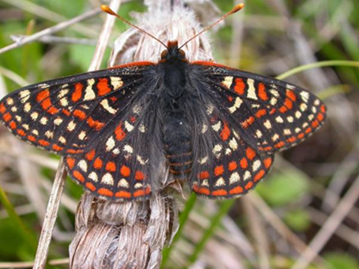
Corresponding author: Paul Severns, paul.severns@uga.edu
Summary by Ethan Hackmeyer
The Taylor’s checkerspot butterfly, notable for its checkered orange, white and black coloring, is a butterfly species native to the remnant grasslands of the Pacific Northwest of North America. Critically endangered, the Taylor’s checkerspot heavily relies on a caterpillar food source that is being infected by a fungus that has recently invaded North America.
English plantain, a plant considered a non-native weed, was introduced to western North America over 300 hundred years ago, and yet it is the primary caterpillar foodplant of the Taylor’s checkerspot butterfly. Verdant and abundant at low elevations in Oregon and Washington throughout the year, the plantain is a common and predictable foodplant for the butterfly. Being such a readily available and convenient foodplant, appears to have resulted in Taylor’s checkerspots abandoning their previous native seasonal foodplants in favor of the continuously available, non-native plantain. While the plantain has been a dependable and predictable food source for the Taylor’s checkerspot for over a century, the fungus Pyrenopeziza plantaginis, introduced in the mid-2000s, causes leaf tissue necrosis on plantain during the winter, the checkerspot’s post-diapause caterpillar stage. With the infection causing necrosis for approximately six weeks, the remaining Taylor’s checkerspot populations are expected to struggle, as their previously predictable food source is now unreliable.
CEID member Paul Severns, and co-author Melinda Guzman-Martinez, provide new evidence in their recent study that suggests severe P. plantaginis infections in northwestern North America, “has altered eco-evolutionary foodplant interactions to a degree that threatens butterfly populations with extinction.” Six of eight currently known Taylor’s checkerspot populations are currently dependent upon plantains. Just a single season of high P. plantaginis plantain infection could be enough to wipe out any of the six plantain dependent populations. Unfortunately, there is evidence that Taylor’s checkerspot populations have already gone extinct due to the new plantain disease.
To accurately gauge which foodplants might be available during the different periods of Taylor’s checkerspot development, Severns and Guzman-Martinez constructed temporal profiles of the butterflies, the plantains, and other suspected native, ancestral foodplants. Both the butterflies and the plants were observed over a three year period, from 2014 to 2016. To measure the prevalence of P. plantaginis on plantain leaves over time, researchers measured infection rates within randomly selected plots over each season. Previous work by Dr. Severns indicated Taylor’s checkerspot larvae would not consume plantain leaves with a level of 50% or above leaf crown necrosis; therefore, 50% was decided to be the cutoff point to indicate severe infection.
English plantain was found to be the sole foodplant, when not diseased, that could provide adequate resources throughout the entire Taylor’s checkerspot life cycle. Native foodplants were only available during certain points of the checkerspot life cycle, but none were present throughout, indicating that before plantain dependence, Taylor’s checkerspots likely fed on different plant species throughout the year. At least one species of Castilleja was likely an ancestral foodplant, as well as Collinsia parviflora.
Castilleja levisecta, a native foodplant being considered for use in Taylor’s checkerspot conservation and reintroduction, which is also an Endangered Species, was found to have little available foliage for Taylor’s checkerspot during its post-diapause life cycle stage, the same time period in which necrosis on plantain leaves reduces food availability for Taylor’s checkerspot larvae. This presents potential issues with C. levisecta being used as a foodplant substitute, as it will likely provide inadequate resources for the larvae at the same time that the larvae’s typical food source is also absent.
Conservation of the plantain-dependent Taylor’s checkerspot populations presents challenges, both practical and legal. On the practical front, not much is currently known about P. plantaginis including its method of dispersal and infection. Questions still remain concerning the ancestral foodplants and their spatiotemporal availability. Legally, the endangered status of the Taylor’s checkerspot also prevents most fungicides from being used in their vicinity, due to possible unintended effects of fungicide use on the butterflies or the ecological community that supports them. Severns and Guzman-Martinez note that,“Land managers should consider researching the safe application of fungicides and establishing butterfly-sustaining populations of alternative host plants to manage P. plantaginis disease and mitigate for severe disease outbreaks, regardless of whether such actions may be counter to typical conservation paradigms.”
Severns, P.M.; Guzman-Martinez, M. Plant Pathogen Invasion Modifies the Eco-Evolutionary Host Plant Interactions of an Endangered Checkerspot Butterfly. Insects 2021, 12, 246. https://doi.org/10.3390/insects12030246
